Chris Baty's Blog, page 137
October 28, 2016
NaNo Trick or Treat: Love What You Write

Everybody knows that Tumblr loves Halloween, and that Halloween heralds the start of NaNoWriMo! To get into the holiday spirit, we’ve asked Wrimos from around the world to share the best “trick” and best “treat” they know to help themselves reach 50K in November. Today, participant Robyn Stillings shares their trick and treat advice:
Don’t talk to me about the passage of time.
As I’ve aged well into my 20s (and as time seems to speed up with age), I’ve accrued a number of catchphrases–mostly as a part of wishful thinking that my life is somehow a sitcom. While this has yet to be effectively disproved, the odds are pretty low.
This phrase seems more and more relevant: “Don’t talk to me about the passage of time.” Don’t get me wrong! It’s my favorite time of the year! Pumpkin spice lattes, hot chocolate, hoodies—oh, and I can take my knitwear out of storage! But somehow, October just keeps coming around. And the NaNo forum wipe makes my heart beat a little faster with both excitement and anxiety, every time.
I’ve grown up alongside NaNoWriMo—this will be my 12th—and with that kind of history, you must be thinking I’ve garnered some wicked tricks for finishing!
To which I respond with a hearty shrug and the nasal sound of indecision. You can be the judge of that.
I don’t mean every word. No one loves every word of what they write, not the first time around. But love your story. Trick yourself into wanting to find out what’s next if you’re a pantser; and if you’re a planner, trick yourself into getting the story to retell itself to you so you can tell it better.
I’ve found that the slog comes when you’re bored with your own story, when the act of crafting it feels more like work than like storytelling. If you’re stuck, skip that part, and move on to the next part that gets you excited! You can always come back to that other bit later.
We all go through periods of feeling like what we create is crap. Artists don’t suffer in order to be artists, artists suffer because they work hard to turn their creation into art. But first, you need to create. Don’t drag yourself down during the fun part.
Here’s the exciting thing—the treat fuels the trick. From the start of NaNoWriMo, one oft-repeated tip has been—well, peer pressure, for lack of a better term. Tell everyone you know, tell your friends, tell your family…
That might have worked when I was younger, but it loses its magic after the first couple of times. Now, I urge you to find that friend. You know the one. The one who will latch onto your ideas and ask you questions about your world and your story, and give you all the right emotions when you tell them what your characters are going through. They are your captive audience. They are your focus group.This friend will make you excited for the next part of the story. This friend will tell you if what you have planned isn’t going to pack the punch you want it to—and help you figure out what will.
Now, I’ve got some ideas to bounce before November 1st. Don’t talk to me about the passage of time. Especially if that time is the 30 days of November.

Robyn lives in Vermont with friends who support their writing habit, two cats who disrupt their writing habit, and an extensive yarn stash. They can be found on Twitter (@stillarobyn), and their short fiction is available for purchase on their website (http://robynastillings.weebly.com/). When not writing, Robyn is usually playing with yarn. Or reading fanfiction. They read a lot of fanfiction.
Top photo by Flickr user l.giordani.
October 27, 2016
Revisiting Favorite Childhood Novels
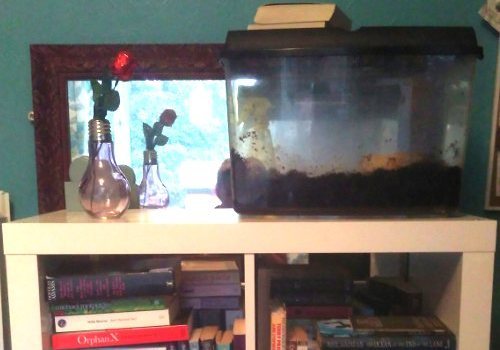
All writers have known the joy of being lost in a good book. This month, we’ve asked NaNoWriMo participants from around the world to share their personal libraries with us–the books that give them insight, inspiration, and that keep them turning the pages again and again. Today, participant Carneika Washbrook shares how her favorite authors from her childhood have helped her become the writer that she is:
This is my bookcase. Well, it’s one of three in my house, so I guess it’s my favorite. It has some books from my childhood, some of my favorites, and ones I haven’t got round to reading yet.
On the bottom left is some of my mom’s old Enid Blyton books. She kept them in the loft for me because she knew how much I loved to read them as a child. I still have a flick through them as an adult because it’s nice to get back into those old worlds I used to visit.
I’m pretty sure Enid Blyton was the first author to get me really interested in reading. The Magic Faraway Tree is still one of my favorite books to this day.
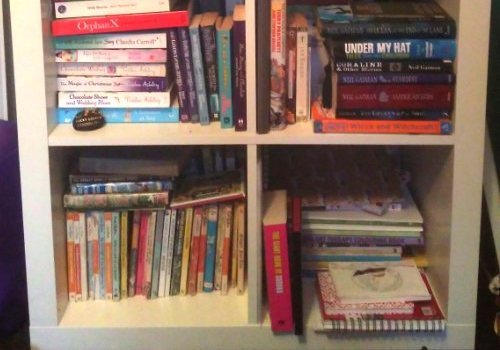
The top right books are my fantasy/sci-fi books, including The Hobbit, Hitchhiker’s Guide to the Galaxy, and my current favorite author, Neil Gaiman. These are the books that inspired me to become a writer as an adult.
I’ve read The Hobbit more times than I can remember. Yet I’ve never made it all the way through Hitchhiker’s Guide to the Galaxy. It gets so confusing at times that I have to reread whole chapters. But it is definitely worth reading.
Discovering Neil Gaiman’s books was a turning point in my life. It was as if the books I read as a child had grown up into these magical novels. They are escapism at its best.
If I had to pick a favorite, I would say Ocean at the End of the Lane. This book freaked me out so much, like a lot of his books. But I wanted to restart it as soon as I’d finished it. If I could become half the writer that Gaiman is I would be so happy.
Finally, on the top left is my other books, my miscellaneous section. They are books I’ve been sent to review; chick lit I flick through when I need something easy to read; and a few murder mysteries for when I’m feeling like reading something different. It’s always good to get out of your comfort zone when reading.

Carneika is a 25-year-old Social Media MA student from the West Midlands, UK. She loves to write short stories and rhymes, but hates that she’s never been able to see a NaNoWriMo through. She loves fantasy fiction or a good mystery (as long as there’s no gore). But she’ll read any book you can recommend at least once. She blogs about reading, writing and life at ihopeyouretakingnotes.wordpress.com. Follow her on Twitter @carniecreek.
October 26, 2016
NaNo Prep: 3 Tips for Conquering Procrastination
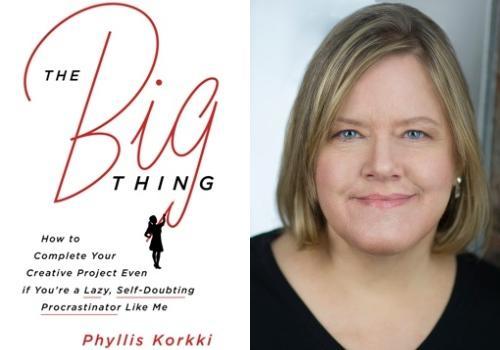
As November draws closer, the dreaded specter of that arch-enemy, procrastination, looms ever larger. Luckily, author Phyllis Korkki is an expert on how to defeat the procrastination monster in order to finish your creative projects on time:
I’m excited to participate in NaNoWriMo this year because it embodies the spirit of my book, The Big Thing: How to Complete Your Creative Project Even if You’re a Lazy, Self-Doubting Procrastinator Like Me. In fact, I interviewed Chris Baty, the founder of NaNoWriMo, for my book because his story is so inspiring. He recounted to me how he sent an email to some friends in 1999, inviting them to join him in writing a novel in a month. Twenty people joined him that year. Now, hundreds of thousands of people around the world participate in NaNoWriMo.
As I point out in my book, we tend to procrastinate on big personal projects like writing a novel because no one else is asking for them, and we believe our future selves will get the work done. Meanwhile, our present selves work on something that is easier or more pleasant, or that another person is demanding that we finish by a certain deadline. But guess what? All too often, our future selves fail to come through for us, and we never finish our cherished creative project.
NaNoWriMo removes several major obstacles that prevent you from doing this great, scary, unique thing:
It gives you a deadline where none existed before.It creates outside accountability.
It encourages you to accept–no, to embrace!–imperfection.
As you prepare for your November adventure, I offer these words of advice to help carry you through to 50,000 words:
1. Find an accountability buddy.Figure out now where other participants are gathering, and use that community to help hold yourself accountable. Find a NaNoWriMo accountability buddy–either in person or online–whom you can text, email or call each day to egg each other on. Or, do something I did while writing my book–pay someone to call you every day to encourage you to write, and have them check back later to make sure you’ve done it. (I found someone–she turned out to be a dairy farmer in Washington state–by posting an ad on Craigslist.)
2. The hardest part is to start.Repeat after me, now and each morning: The hardest part is to start. That space between not doing and doing can stretch into infinity if you don’t put tremendous effort into starting. What’s wonderful is that once you start, the power of inertia–the force that causes you to lollygag, loaf, and generally avoid writing–magically turns in the opposite direction and keeps you working.
3. “Don’t get it right, just get it written.”Each day as you write your allotted 1,577 words, repeat after me: “This is bad – really bad.” Variations: “This is horrible.” “I am so embarrassed by this mess.” “These characters are so wooden they could be used as kindling.” “This doesn’t make any sense!” As Chris Baty told me: “Don’t get it right, just get it written. Be assured: It’s going to be bad.” Too often our own “crippling expectations for quality” hold us back, he said.
Relinquishing some glimmering idea of perfection can give you great freedom and energy. Remember, you never have to show your writing to anyone, and it may turn out to be better than you realize–or be the basis for something great down the road. The point, above all, is just to do it, and that is what makes NaNoWriMo so powerful.
Phyllis Korkki is an assignment editor and reporter for the New York Times Sunday Business section and the author of The Big Thing: How to Complete Your Creative Project Even if You’re a Lazy, Self-doubting Procrastinator Like Me (Harper). She is from Minnesota and previously worked at the St. Paul Pioneer Press and the Minneapolis Star Tribune. She lives in Brooklyn.
October 25, 2016
The Three-Tip Shortcut to Unleashing Character Personality
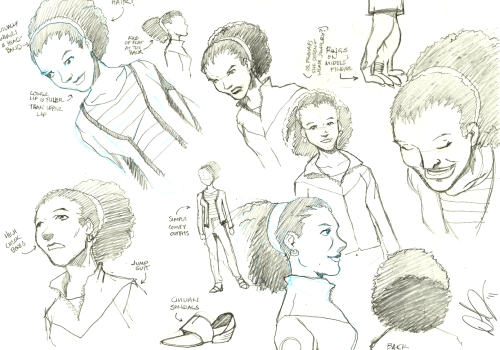
Last month, participant Melissa Rose told us about four ways to create stand-out character names. Today, she shares with us her three-step writing hack for unleashing the personalities of your characters on the page:
If you’re anything like me, you’re excited about NaNoWriMo, which is now only a week away! While it’s sometimes easy to get lost in the sheer joy of creating new scenes, plots and characters, it can also be a challenge to draft engaging, multifaceted characters when you’re focused on your word count.
As November rolls around, you’ll begin to see that the amount of effort you put into understanding your character’s personality determines how well your story will unfold. Your character’s personality is like a budding flower: the more you nurture it, the more it will blossom! So how do we create realistic and believable characters that jumpstart our story plots?
There are several useful interview templates online for character personality development. Make your characters pull up a chair and don’t be afraid to ask them the tough questions. Delve into their strengths and weaknesses. Are they idealists? Protectors? Inspirers? Find out what motivates them, what their fears are, and what habits they can’t seem to shake-–like the curl-twirling daydreamer, or the nervous nail-biter.
2. Draft trial scenarios.I can’t be the only one who loves putting my characters in crazy, disturbing, and downright dreadful settings, just to see how they’ll work their way out. You should try it too! Step away from your story plot for a bit and try some experimental scenes. See what happens. Do they remain true to themselves? Have you suddenly realized that your fearless space commander also has a compassionate side? It’s okay to do some personality tweaking.
3. Make your characters memorable.Keep in mind that you’re the mastermind behind your novel, and now is your moment to shine as the author! It will be so much easier to create mind-bending twists or an epic finale if your readers are invested in your characters from the start. Try to make your characters relatable, yet unique. From the flawed hero to the culturally diverse heroine, don’t be afraid to dig deep. The more your readers can identify, commiserate with, or relate to your characters, the more memorable they’ll be.
Bonus Preparation Tip:If you haven’t been an effective pantser in the past, then proper planning before November 1st could be vital for your NaNoWriMo success. Despite your favored creative approach, there is still preparation involved in writing, whether you’re the careful planner or you mentally catalogue your ideas. Using this three-tip shortcut to develop character personality will cut down on redrafting time and will thrust your plot forward, helping you to reach a very satisfying story conclusion in a short span of time–November’s 30 days, to be exact!

Melissa L. Rose is a YA Fiction writer born in Maryland, USA. She is an active member of the SCBWI writers’ organization and the Inked Voices critique group. When she is not writing, she can be found counseling troubled youth, spending hours reading in bookstores, and taking care of her free-spirited pup. She has always been passionate about writing for the young and the young at heart. You can connect with Melissa on Twitter @MelissaRWrites.
Photo by flickr user Lunatics TV.
October 24, 2016
Road Trip to NaNo: Building a Supportive Writing Community
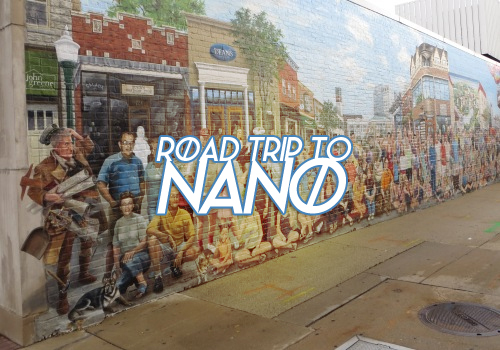
NaNoWriMo is an international event, and we’re taking a Road Trip to NaNo to hear about the stories being written every year in our hundreds of participating regions. Today, Tim Yao, our Municipal Liaison in the USA :: Illinois:: Naperville region, shares some advice from one of our homiest regions:
People arrive carrying a dish of food, a box of cookies, or bottles of pop. Already, savory smells from crockpots tease one’s appetite. As soon as they’ve dropped off their contributions and coats, people engage in the ice-breaker, some of them carrying the customary stuffed animal that will later play a role in our group photo.
This is how the pot luck kick-off party unfolds every year here in the heart of the Naperville region. It’s homey, filled with regional traditions, and exciting for newcomers and more experienced participants alike.
Naperville itself is a beautiful, vibrant city of over 140,000 people; as a region, Naperville represents the many cities and suburbs west of Chicago. Our third annual Library Crawl–coordinated by Sarah Kovac (sarahk06)–offers write-ins at fourteen area libraries. In October, with the sponsorship of our core partner libraries in Naperville, Woodridge, and Glen Ellyn, we offer five preparatory workshops to ensure everyone is ready for November.
“Each NaNoWriMo online forum or region […] provides to those who interact within them support that could be the catalyst that helps propel them across the 50,000 word finish line.”
The Naperville region’s greatest treasure is our year-round writing group, the Writing Journey. It was created at the end of the 2006 NaNo season because many of us had had too much fun for the camaraderie to end. The Writing Journey is an a la carte writing group (fee-free and open to all) where members can lead “paths”. A path can be a one-time event (like an outing to a musical or a Shakespeare Reader’s Theatre), or a continuing activity (like a writer’s critiquing workshop, a short story anthology, or a short fiction query path). The members of the Journey lead our NaNoWriMo preparatory workshops and help host many of the write-ins.
Many of you may already engage in writing communities like ours. If not, I encourage you to try it. Each NaNoWriMo online forum or region is unique, but they all have things in common. These communities provide to those who interact within them support that could be the catalyst that helps propel them across the 50,000 word finish line.
Some people have said it takes a village to raise a child. Our novels are very much the children of our mind. While the core story is something that comes from you, writing need not be a solitary, lonely activity. NaNoWriMo provides opportunities to make writing fun, to make new friends and bounce ideas off of them, and to give and receive comfort when the challenges of novel writing are too much.
Want some more actionable advice? Here are some tips to ensure you’re prepared for NaNoWriMo:
Find some (2-5) friends and do a story wall. For NaNo preparations, this can be done in about 30 minutes. Use five index cards to write down key elements of your novel (e.g., protagonist, antagonist, basic plot, setting, and questions you need help answering). Take five minutes to tell your story idea to the group and to ask your questions; then let them ask clarifying questions and help you brainstorm answers.Try using XMind or Freemind to do some novel plotting and planning. Mind maps are an easy way to outline; you can drag and drop items to reorganize them into a structure that makes sense to you.
Read other advice from our past workshops: naperwrimo.org/prep
Good luck!
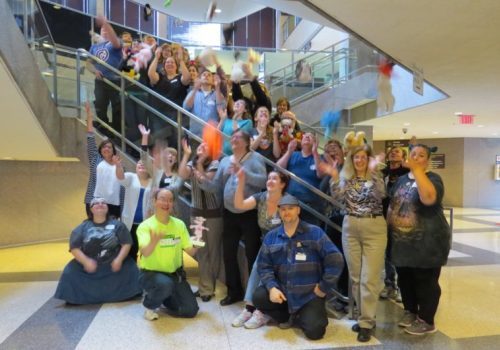
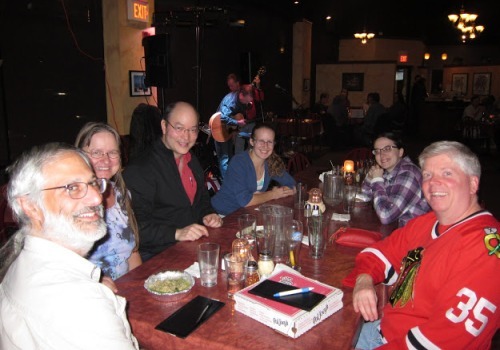
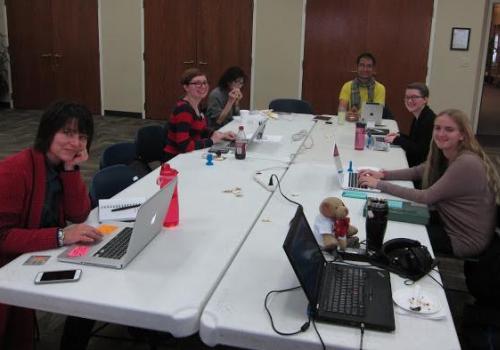

After finding out about National Novel Writing Month (NaNoWriMo) in 2003, Tim has written a first draft of a novel every year since then. He became a volunteer co-Municipal Liaison for the Illinois::Naperville region in 2005, helping to found the writing community the Writing Journey in 2006. You can visit the Naperville region website at http://naperwrimo.org/. Tim is the author of short stories in six anthologies of the Writing Journey. In real life, he is a Distinguished Member of the Technical Staff at Nokia.
Top photo by Flickr user David Wilson.
October 21, 2016
NaNo Trick or Treat: The Daily Progress Blog

Everybody knows that Tumblr loves Halloween, and that Halloween heralds the start of NaNoWriMo! To get into the holiday spirit, we’ve asked Wrimos from around the world to share the best “trick” and best “treat” they know to help themselves reach 50K in November. Today, participant Joseph V. Carusone shares his trick and treat advice:
It seems to me that the only things more difficult than writing a 50,000 word novel in 30 days are child birth, climbing Mount Everest, and watching a presidential debate without screaming at the television set. Therefore, any hopeful NaNoWriMo participant must find new and creative ways of tricking and treating themselves into writing the requisite 1,667 words per day.
Trick:A trick I used last year during my first NaNoWriMo endeavor was to create a blog in which I would chronicle my daily progress. Each day I would post a blog entry that tracked the amount of words I accumulated, detailed the physical location where I wrote (ie. my desk at home, the local library, a cafe, etc.) and recounted any interesting anecdotes about how my writing went.
The point of the blog was not only to document the NaNoWriMo process for my friends, family and fellow writers, but, more importantly, to shame me into writing each and every day. Skipping a day of writing during November and consequently running the risk of falling catastrophically behind is a dangerous thing in itself; but skipping a day of writing and THEN having to create a blog post advertising my complete and utter lack of writing was a highly embarrassing prospect.
I still remember several nights in which I was dangerously close to falling asleep on my couch with a nice warm blanket tucked up under my chin as the din of a football game droned on in the background, when, just as my eyelids were about to succumb to gravity, I remembered the blog. I envisioned the horrible feeling of creating a post that said something like, “Last night I wrote 0 words, therefore I am falling behind, behind, behind and will never catch up. Woe is me. Woe is me!” This thought prompted me to get off the couch and stumble to my computer to knock out some words just to avoid the embarrassment of that overly dramatic and awkward blog post.
Now don’t get me wrong; there were some days where I simply did not produce any words, and those nights I was forced to create one of those embarrassing blog posts stating that I only wrote 100 words, or 60 words, or 0 words, but I can guarantee that the days in which I did not write 1,667 words were significantly fewer due to the specter of a humiliating blog post hanging over my head.
Treat:In this case, the treat is the result of the trick. You trick yourself into writing and the treat is the unparalleled sense of satisfaction that comes with hitting “submit” and posting news of your success to the whole world (or, more accurately, your five blog readers that all share your last name).
Now, you might not want to create your own blog, and that’s ok. The same effect can be achieved by forcing yourself to keep a daily journal in which you track your daily output, or by telling a loved one how important it is that you write every day and then keeping them abreast of your daily word count. Having someone to hold you accountable as you write–whether it’s your internet community, your best friend, your mom, or even yourself–is a great way to keep on track to reach 50K by the end of November.

Joseph V. Carusone is a 33-year-old writer from Albany, NY, who spends too much time watching sports on TV, reads too many online articles about Star Wars, and has become an expert on playgrounds thanks to his 3-year-old son. Joseph is currently in the process of polishing the third draft of the novel he wrote for NaNoWriMo 2015. Read his blog The Sinister Scheme of Phalanxes at www.TheSinisterScheme.com and follow him on Twitter @JosephVCarusone.
Top photo by Flickr user Thomas Hawk.
October 20, 2016
Drawing Inspiration From Writers in Real Life
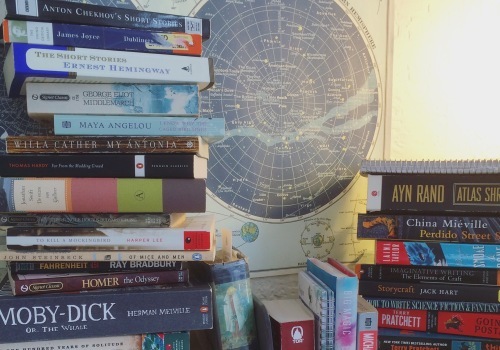
All writers have known the joy of being lost in a good book. This month, we’ve asked NaNoWriMo participants from around the world to share their personal libraries with us–the books that give them insight, inspiration, and that keep them turning the pages again and again. Today, participant Sarah West shares how her favorite authors have inspired her to find the time to keep writing:
Currently my bookshelf is less shelf, more stack! It’s filled with science fiction, fantasy, young adult and classics. Some modern authors I love right now from these genres include Patrick Rothfuss, Neil Gaiman, Ursula K. Leguin, Laini Taylor and V.E. Schwab. Of the dead, I prefer H.P. Lovecraft, Bradbury, Steinbeck, the Brontë sisters, and Shakespeare. My writing is inspired by every one of these authors and more.
They inspire me by what they’ve put on paper: compelling language, evocative imagery, unique metaphors, plot twists that make my brain spin—I rank my favorites in a spiral notebook. But even more significantly, the reason I can’t write unless surrounded by familiar names, is the way these authors inspire me off the page.
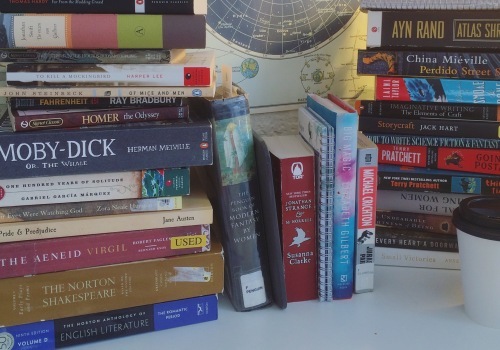
With all due respect to Hemingway, I disagree that good writing necessitates “sitting at the typewriting and bleeding” (ew) because my favorite authors were not martyrs. They were teachers, friends, siblings, parents, or otherwise average, functioning normal human beings (albeit with a small tendency towards the melodramatic). And just like us, they suffered through the chaos of day-to-day life.
John Steinbeck, for example, would not see success until after his sixth novel. Biding his time, he worked as a tour guide at Lake Tahoe. Mary Woolstonecraft was a governess. You guys, the creator of Frankenstein cared for children. She even wrote a children’s book!
Kurt Vonnegut worked at a car dealership, Chuck Palahniuck at a movie theatre. Stephen King was a janitor. Isabel Allende and Patrick Rothfuss raised children and still found time to write prose that makes me cry, even after the second (and third) times through.
My favorite authors inspire my writing because, despite the crazy distractions of everyday life, they wrote. And my bookshelf is living proof that if they could do it, I can too.

Sarah West has an English Literature degree from Colorado State University. Despite avoiding creative writing while she had the spare electives, she now writes as much as possible in her free time to make up for it. She tends to fill notebooks with short science fiction, tragicomedy, poems and music and has been published on The Rumpus. She currently lives in San Francisco where she works at a boutique public affairs firm.
October 19, 2016
5 Tips for Educators Using NaNoWriMo in the Classroom
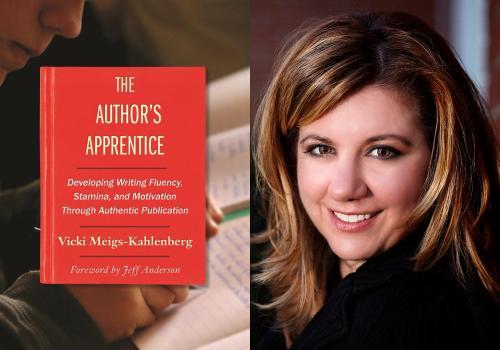
We’re almost ready to test out our brand-new Young Writer’s Program website! The final bugs are being worked out so that teachers and young novelists alike will be able to use the new and improved website for NaNo 2016. To receive an alert when the new YWP site goes live, sign up here. Meanwhile, author and educator Vicki Meigs-Kahlenberg has given us some tips about implementing NaNoWriMo in the classroom:
October is one of my favorite times of the year. I love the sweater weather, the changing leaves, and everything pumpkin spice. But my absolute favorite thing about this time of year is gearing up for NaNoWriMo! As great as it is, participating in the program at all can seem like a crazy endeavor–so why on earth would you ever attempt to write novels with a group of students who don’t even particularly care for writing in school?
Because…it’s magical.
Much like the changing leaves, exploding with vibrant colors, so too will your students’ attitudes and efforts in writing change and explode with possibilities even they never imagined. I have been a middle school teacher for more than 20 years, and I can honestly say that nothing compares to writing novels together as a class. In my experience, it’s the single most impactful academic experience that a student can share with their classmates. Writing novels builds confidence and motivation for students (in writing and in other areas of life); reinforces other lessons and makes those lessons meaningful to our students; and helps students feel like they are a part of something that matters, something real.
Here are a few tips for a successful trip to NaNo Land with your class this fall:
1. Integrate noveling into your existing curriculum to give authenticity, meaning, and purpose to what your students are already learning.Participating in NaNoWriMo helps students connect the writing work that authors do in the real world with the writing work that we do within our classrooms. It provides validation and a wonderfully authentic opportunity for students to apply the literary elements you are already teaching–such as characterization, plot, setting, and conflict–to their own writing. They also get to demonstrate their knowledge of literary devices such as flashback, imagery, and irony throughout the month in the same way that real authors do.
Additionally, something unexpected occurs for every student who takes part in this ridiculous challenge: after writing their own novels, students will never read another story without knowing the work that went into developing each character and their actions. They will no longer casually breeze by vivid details, deliberate word choices, or embedded symbolism. Learning the skills in the reading portion of the curriculum, and then fearlessly crafting and applying those skills in their own writing, makes a strong impression. This synthesis of knowledge bridges the gap between reading and writing and brings new meaning and a heightened awareness into their everyday reading and writing lives.
2. Write with your students.C’mon, admit it. If you teach English or language arts, you know that somewhere deep down inside you have this dream of writing “The Great American Novel” one day. Carpe this Diem. If you truly want to make an impact with your students, you can’t just teach novel writing; you have to get in there, get your hands on that keyboard, and experience novel writing side-by-side with your students. You have a writer’s voice, and the world needs to hear it.
3. Build a true community of writers within the classroom.Out in the real world, writing communities serve to hold their members accountable, to provide support and encouragement when needed, and to offer feedback at all steps in the writing process. Wouldn’t it be wonderful if our students could come to expect this same kind of support system within our classrooms?
The YWP website has many tools you can utilize to engage and support your students as they navigate their way through their novels. You can create a virtual classroom, post announcements, assignments, and even writing challenges. The new YWP site will even include writing spaces for students to draft and save their novels, and updated forums for improved conversation and communication. It is so comforting to know that even when we are writing on our own at home, we are never alone. That sense of community and connection with your classroom can make all the difference.
4. Build a true community of writers out in the community.You already know you are crazy for taking on this insane challenge with your classroom, so why not spread the word out there in your community? I’m serious: share with your community what you are setting out to accomplish for the month, and get them to join you in your efforts.
Contact your local newspaper and news station to see if they’d be interested in reporting this story of your class taking on insurmountable odds to write novels in 30 days. Host “write-outs” around town for your students to get together and write in the evenings or on the weekends in coffee shops, book stores, or even the mall food court. Don’t be shy–the more people see you and hear about what you are doing with your class, the more the excitement builds. No doubt everyone you talk to will be amazed by your enthusiasm and dedication to your students.
5. Celebrate a job well-done.Novel writing is both messy and empowering. Through the process, students develop writing fluency, stamina, and the ability to produce higher-quality on-demand writing–and that’s something worth celebrating!
See if you can come up with a way to show your students how proud you are of them. Share your idea with local businesses and see if they’d be willing to donate goods or gift certificates for the students who meet their word count goals. (Our local ice cream parlor gave us free ice cream cone certificates as awards!) Participating in NaNoWriMo shows our students that we believe in them, even when they think that what we are asking is impossible.
Vicki Meigs-Kahlenberg is the author of
The Author’s Apprentice: Developing Writing Fluency, Stamina, and Motivation through Authentic Publication
. She is an experienced teacher, writer and educational consultant. As a middle school teacher for nearly two decades, she has helped hundreds of students become published authors. She aims to help all English teachers reclaim their classrooms and get their kids writing for real. She loves NaNoWriMo and hopes to make it part of classroom instruction everywhere.
October 18, 2016
From Our Young Writers: When the Going Gets Tough, Keep Going!

In addition to the main event every November, NaNoWriMo provides free creative writing resources to educators and young participants around the world through our Young Writers Program. This month, we’ve asked some of our young writers to share their own words of wisdom. Today, participant Raina Xin urges you not to settle for less than you–and your novel–deserve:
The first time I did NaNoWriMo was in 7th grade. Our English teacher1 made it a class assignment, with dedicated writing time in class, discussion sessions, and writing prompts galore. On our classroom’s YWP dashboard was a giant thermometer that filled up as we updated our word counts.
I started out at a reasonable but respectable 15,000-word count goal. 500 words a day, I thought, woefully naive. I can do that.
In short, I couldn’t. My thermometer still filled up at a steady rate–but it did so because my word count goal shrank far more than my actual word count grew. The YWP has a feature that lets you set your own word count goal, and then change it as much as you need to.
15,000 words.
10,000 words.
7,000 words.
I finally settled at a measly 5,000 words. I felt a little disappointed, but I reassured myself that I had won. I technically didn’t cheat; my actual word count was 5,000 words, the thermometer was at 100%, and even if I had changed my word count goal a few times in the middle, there was nothing in the rules against that. I quickly moved on.
I did various NaNoWriMo events—November YWP NaNo, a couple of Camp sessions—in the years after that. Every time it ended up the same way. Lofty word count goal, which eventually dwindled down by the end of the month, just enough for me to reach it and collect my prizes. I never really felt satisfied, but I wasn’t bothered too much by that, either.
“I knew that if I gave myself a flexible word count goal, it would end up shrinking. I needed something solid, something I couldn’t just change on a whim, when the going got tough.”
Then, November 2015 came around, and I decided something needed to change.2 I signed up for a YWP account, thought hard for a few minutes, then logged out and signed up on the adult site. I knew that if I gave myself a flexible word count goal, it would end up shrinking. I needed something solid, something I couldn’t just change on a whim, when the going got tough. The 50,000 word goal of the adult program was higher than I had ever attempted, but it was non-negotiable. This was a proper mountain to scale, not some dirt hill I could raze and walk over, claiming to have climbed it.3
That was harder than anything I’d done before. I didn’t have a habit of writing continuously, on a schedule, so my time management wasn’t the best. There were times I thought there was no way I was going to make it;4 but that 50,000 word count goal was set in stone, and it wasn’t going down.
“Never settle. Your novel is important. It deserves to be written, and that’s why you’re here.”
I was trapped by that goal, but in a way, it was also liberating. I couldn’t do anything about it except for write as much as I could, and chip away at those 50,000 words one by one. I wrote late at night, I wrote during Thanksgiving, until finally, on November 31st, I ended up with 50,025 words. This was the first time I won—really won—NaNoWriMo, and I was ecstatic. I never imagined I could do it, but there it was, the purple winner’s badge next to my profile picture. The feeling of pride I had been missing all those years prior came rushing in, and I was on a noveling high for the rest of the year.5
But here’s the takeaway from this blog post:6 Never settle. Your novel is important. It deserves to be written, and that’s why you’re here. Not for the purple winner’s badge or bragging rights or the prizes from the generous sponsors, though those are all great.
Ultimately it’s about your novel, and only you—not the NaNoWriMo community, not this blog—can decide how much that means to you. And I get it, life happens and sometimes it disrupts writing, but if your novel means anything to you, don’t settle.
Don’t you think your novel deserves your best effort?
Because I do.
1. Shoutout to the awesome Ms. Cenera! I hope you’re still doing NaNoWriMo with your class this year.
2. Wow. I sound like I staged an intervention, and made myself go to Procrastinators Anonymous meetings.
3. And there may have been a rumor that the adult program had better prizes, which might’ve influenced my decision somewhat, but keeping with the theme of personal growth and discipline, let’s ignore that fact.
4.
If you connected the points on my word count bar graph last year, it would look like a parabola.
5.
Until January 2016, when editing time kicked in.
6. Spoiler alert: it’s not “Don’t use YWP.” Flexible word count goals are great for those who have the self-control and discipline to leave them be, a group that unfortunately doesn’t include me.

Raina Xin is a student and writer living in St. Louis who—for the moment at least—is a sixth grader at heart. She writes MG novels that have more dark humor than they should, but she’s never been one to follow all the rules. When she isn’t off exploring fictional worlds through the magical portals known as “books”, she can usually be found outside, where she may or may not be melting from the sunlight and fresh air.
Top photo by Flickr user Gael Varoquaux.
October 17, 2016
Road Trip to NaNo: Don’t Be Afraid of Writing Setting
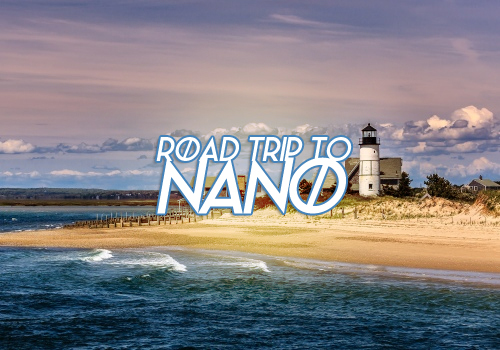
NaNoWriMo is an international event, and we’re taking a Road Trip to NaNo to hear about the stories being written every year in our hundreds of participating regions. Today, Lori Watson, our Municipal Liaison in the USA :: Massachusetts :: Cape Cod region, shares some tips on how to integrate detailed, informative, and important settings into your novel:
Welcome to Cape Cod, MA!
One of the best things about virtual road trips? No traffic. With only two bridges providing access on and off Cape, things can get pretty squirrelly–especially during tourist season. Still, people continue to flock to the Cape. The beauty of the seashore, the serenity of seaside villages, the taste of salt on your tongue as the sea breeze plays with loose strands of hair…
It’s practically poetic.
In fact, the setting here has been muse to Pulitzer Prize winning poet, Mary Oliver. It’s inspired contemporary authors such as Mary Higgins Clark, and classic writers like Henry David Thoreau, Thornton Burgess, e.e. cummings, Edward Gorey, Sylvia Plath, and more. With a legacy like this, you’d think writers lucky enough to live here would just ooze vivid settings from their pores directly onto the page. If only it were that easy.
“Hi, I’m Lori, and setting is my weakness.”
Anyone with me? When you read, do you skim long descriptions? When you write, do you skimp on settings for fear of boring your readers? Tell me I’m not alone.
Thankfully, one NaNo participant in my region does ooze setting, pores to page. She’s shown me that lack of setting leaves the reader floundering for context, while good setting grounds the reader and enhances the story.
I’m still in recovery, but here are a few things I’ve learned:
1. Stay in Your Character’s Head.What would your character notice? Would your rough and tumble construction worker really appreciate the exact shade and pattern of the drapes? What effect does the setting have on your character? Does the softness of the couch cushion remind them of Great Aunt Courtney’s house, where they always felt at home? How will that impact their actions in the scene?
The best way to avoid the info dump (and people like me skimming past to get to the good part) is to experience the setting as your point of view character. Setting is best when combined with deep point of view.
2. Describe Setting in Action.Ground your readers in the setting by having your characters interact with their environment. Skip setting for setting’s sake and describe what’s important. Setting that matters will matter to the reader.
3. Use All Five Senses.Even if you don’t use them in every scene, consider all five. What does your character hear, see, smell, touch, taste? These help the setting and character feel more real.
4. Stay in Your Character’s Voice.You’re in your character’s head, seeing what they see. They notice the cluttered kitchen table. They never could find an uncluttered space at home when they were a kid, and somehow that matters to the story. Then you write something like, “The archipelago of undiscovered items across the robin’s egg blue tablecloth drew me in like a fake flower lei does an ocean bound tourist.”
Whaa–? If that’s your character’s voice, great. But if it’s not, it’ll throw the reader right out of the story. Stay in your character’s head, share what matters to them, and describe the setting in their voice.
Challenge:As we prepare for November, my challenge for you is to become aware of your own point of view. What do you notice when entering a new setting? Consider your five senses, how you interact with your environment, etc. Be your own character and discover how setting affects your daily story. Come November, your character’s story will be that much stronger.
NaNoWriMo in USA :: Massachusetts :: Cape Cod
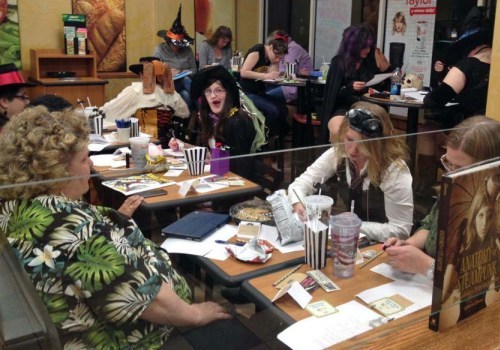
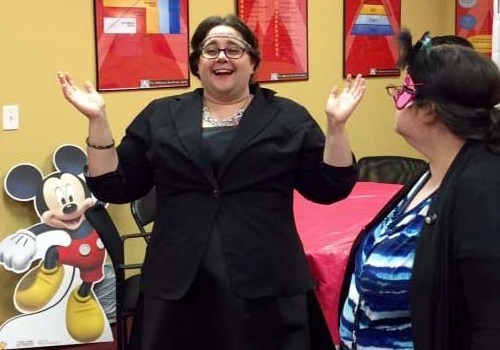
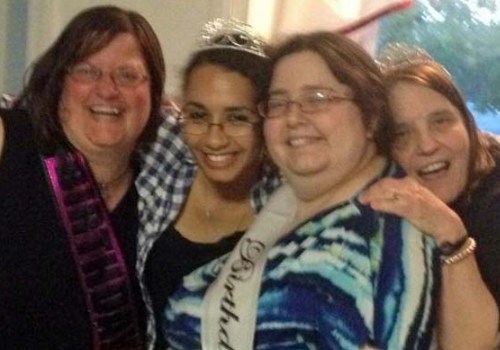

Lori Watson is a 5th year ML to a crazy group of creative Cape Codders, and “fearless leader” to the Plot Bunnies writers group. She’s a wife, mom, writer, reader, homeschooler, steampunk MISFIT, tabletop gamer, and all around geek. Stories are her passion in whatever form they’re told; they connect people and remind us we’re not alone. She’ll be sharing fiction and reality of life with an irregular mind on her new website, LoriWatsonStories.com. Like NaNoWriMo, it launches November 1st.
Top photo by Flickr user Chris Martino.
Chris Baty's Blog
- Chris Baty's profile
- 63 followers



